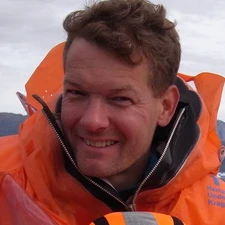Niels Hovius

The 2016 Ralph Alger Bagnold Medal is awarded to Niels Hovius for outstanding research in the field of Earth surface science, as well as for being a key figure in European geomorphology and a versatile interdisciplinary scientist.
Niels Hovius is one of the leading Earth surface scientists worldwide, an excellent communicator, and a versatile and interdisciplinary Earth scientist. He keeps abreast of an impressive range of research areas, from climate science and river dynamics, to organic carbon transfer and burial, hillslope processes, landslide hazards, seismics methods and sophisticated geochemistry. He is always well informed, able to form his own well-thought-through judgement, and keen (and able) to integrate disparate fields and observations into a coherent picture. This diversity is expressed in his scientific agenda. Hovius set out to compile river sediment delivery, but his real early career accomplishment was the establishment of landslide systematics from painstaking counting size-frequency distributions of landslides in New Zealand and Taiwan. He was then drawn to the very active Taiwan mountain belt, leading to a whole series of groundbreaking projects on bedrock incision and the stochastic nature of sediment transport. In a much-cited paper (Dadson et al, Nature 2003), he also established that erosion rates are high where rapid deformation, high storm frequency and weak substrates coincide, regardless of topographic relief. Hovius and his group authored a series of papers that established how earthquakes trigger landslides, and have become leaders in this research field. Another important contribution was the realisation that mass-wasting processes have the ability to sequester large amounts of carbon from terrestrial biomass in adjacent basins. Work with Bob Hilton has shown that the ensuing CO2 withdrawal potentially equals that by silicate weathering. More recent work deals with deep weathering and associated submarine groundwater discharge, and also with the deployment of broadband seismometers as real-time monitors of sediment flow in steep channels. This list is by no means complete, but demonstrates the diversity of his research. It should be noted that this was achieved with minor resources and a small, but always powerful, research group at Cambridge University. Hovius has had an outstanding group of young students and postdocs, many of whom are now important figures in the geomorphology community. At EGU, Hovius has played a key role in developing a strong and vibrant geomorphology community, promoting EGU outreach activities, and most recently establishing the new EGU open access journal Earth Surface Dynamics as one of its founding editors. These are commendable activities, but central to this nomination are Niels Hovius’ fundamental and outstanding scientific contributions to the field of geomorphology and their impact for global Earth surface processes in general.
